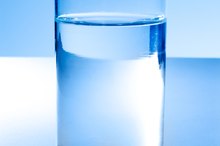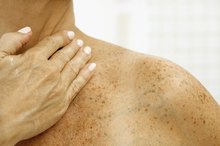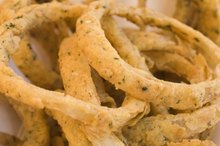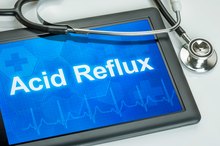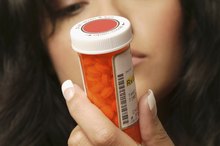Does Weightlifting Cause GERD Symptoms?
GERD, or gastroesophageal reflux disease, is a chronic digestive disorder that occurs when acid backs up from your stomach to the esophagus. Bile backs up and causes heartburn and acid reflux. While many people experience heartburn occasionally, when it happens to you more than twice a week, you probably have GERD. While some foods and activities can exacerbate the condition, the pressure that lifting weights puts on your abdominal muscles is an important factor when evaluating your symptoms.
Symptoms
You should see a doctor whenever you have severe or new chest pains, even though the cause may be gastroesophageal reflux disease. Chest pains resulting from GERD usually begin with a burning sensation that seems to originate in the chest and runs up your throat, leaving a sour taste in your mouth. Other symptoms you might notice include hoarseness or coughing, a sore throat or difficulty swallowing. If these symptoms appear during or shortly after lifting weights, don't assume that weightlifting is the sole cause of your condition. Left untreated, GERD can lead to ulcers or scars on your esophagus.
- You should see a doctor whenever you have severe or new chest pains, even though the cause may be gastroesophageal reflux disease.
- Left untreated, GERD can lead to ulcers or scars on your esophagus.
Basics
Why Does Drinking Water Create Acidity?
Learn More
The sphincter is a muscle that works like a valve to regulate the flow of acid into and out of your stomach. It is only supposed to open when you swallow. Oftentimes, when you bend over to lift a heavy weight, you apply pressure on your lower esophageal sphincter and cause it to open up and release acid that in turn has nowhere to go but up through your throat. The sphincter muscle also is disrupted by excessive weight you may carry around your abdomen and when you lie down too soon after eating.
- The sphincter is a muscle that works like a valve to regulate the flow of acid into and out of your stomach.
Complications
A hiatal hernia occurs when a piece of your stomach protrudes through the muscle wall that separates the stomach from your chest cavity. Side effects associated with a hiatal hernia include gastroesophageal reflux disease. While some people are born with the condition, a leading cause of hiatal hernias is weightlifting. The straining of lifting the heavy weights puts pressure on your stomach and forces the opening. Continuous straining can cause the GERD, or a sudden, extreme lift could bring on the symptoms. While a hiatal hernia and GERD often are caused by lifting weights, you could have a hiatal hernia and experience no gastrointestinal symptoms at all for years.
- A hiatal hernia occurs when a piece of your stomach protrudes through the muscle wall that separates the stomach from your chest cavity.
- While a hiatal hernia and GERD often are caused by lifting weights, you could have a hiatal hernia and experience no gastrointestinal symptoms at all for years.
Workout Rules
What Are the Causes of Heartburn Every Day?
Learn More
If you experience GERD symptoms after eating, wait at least an hour before going to the gym or lifting weights, to prevent the discomfort. Dress in loose-fitting clothes. Tight shirts, belts and cinched waistbands restrict the lower stomach and actually could push the acid up through your esophagus. Avoid the foods that commonly cause you heartburn and reflux, especially on days you'll be working out. Common culprits include garlic, onions, caffeine, and fried and fatty foods.
- If you experience GERD symptoms after eating, wait at least an hour before going to the gym or lifting weights, to prevent the discomfort.
- Avoid the foods that commonly cause you heartburn and reflux, especially on days you'll be working out.
Related Articles
References
- University of Maryland Medical Center: Heartburn
- University of Maryland Medical Center: Gastroesophageal Reflux Disease and Heartburn
- NYU Langone Medical Center: Hiatal Hernia
- Harvard Health Publishing. Hiatal Hernia, What is It? Updated May, 2017.
- GI Society. Canadian Society of Intestinal Research What is the Treatment of GERD? Updated in 2019.
- Choe JW, Joo MK, Kim HJ, et al. Foods Inducing Typical Gastroesophageal Reflux Disease Symptoms in Korea. J Neurogastroenterol Motil. 2017;23(3):363-369. doi: 10.5056/jnm16122
- Panda V, Shinde P, Deora J, Gupta P. A comparative study of the antacid effect of some commonly consumed foods for in an artificial stomach model. Complement Ther. 2017;34:111-115. doi:10.1016/2017.08.002
- Sethi, S, Richter, J. Diet and Gastroesophageal Reflux Disease: Role in Pathogenesis and Management. Lippincott Williams & Wilkins. Curr Opin Gastroenterol. 2017;33(2):107-111. doi:10.1097/MOG.0000000000000337
- Owczarek D, Rodacki T, Domagała- R, Cibor D, Mach T. Diet and nutritional factors in inflammatory bowel diseases. World J Gastroenterol. 2016;22(3):895-905. doi:10.3748/v22i3895
- Cleveland Clinic Health Library. Hiatal Hernia: Management and Treatment. Updated August 17, 2019.
- New York Presbyterian Hospital/Columbia University Irving Medical Center, Columbia Surgery, ESOPHAGEAL DISORDERS PROGRAM. Hiatal Hernia. Updated 2019.
Writer Bio
Linda Ray is an award-winning journalist with more than 20 years reporting experience. She's covered business for newspapers and magazines, including the "Greenville News," "Success Magazine" and "American City Business Journals." Ray holds a journalism degree and teaches writing, career development and an FDIC course called "Money Smart."
